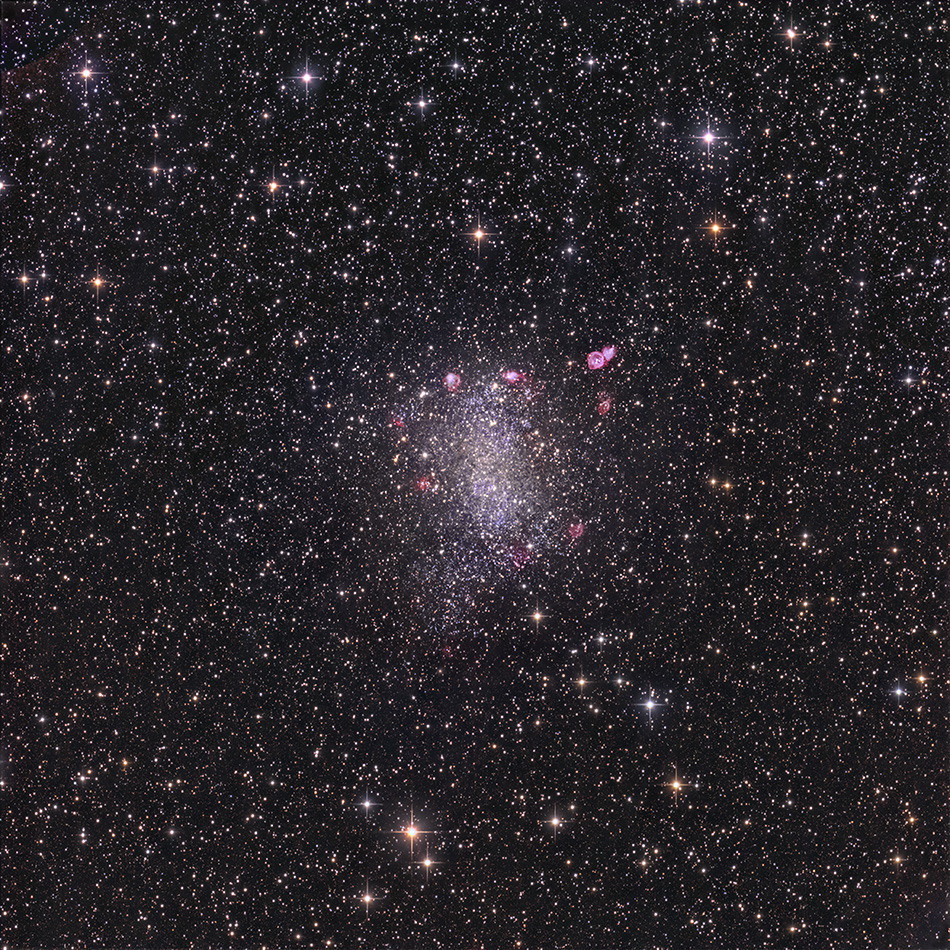Barnard's Galaxy - NGC 6822
Image Credit: Steve Timmons and Donald Waid - Image Date: Sept. 2023
Equipment: Telescope: PlaneWave CDK 14 - Camera: FLI 16803 - Mount: Paramount MI II
Barnard's Galaxy - NGC 6822
NGC 6822 was discovered in 1884 by E. E. Barnard[3] and is commonly referred to as Barnard's Galaxy. It is located in the constellation Sagittarius approximately 1.6 million light years distant[1]. It is classified as an irregular barred galaxy[1] and is similar in structure to the Small Magellanic Cloud[1]. NGC 6822 is a member of the Local Group and is the closest non-satellite galaxy to the Milky Way galaxy[1]. Numerous red H II regions are visible in the image. These are areas of active star formation[2] and are much like the Orion Nebula in our own Milky Way. A particularly impressive bubble-like H II nebular structure[2] is located in the upper right of the image above. Edwin Hubble studied NGC6822 in depth[3]. He surveyed five of the brightest of these H II regions[1]. He also identified 15 variable stars of which eleven were classed as Cepheid variables[1]. Spectroscopic studies have determined the galaxy has a low metallicity indicating a relatively low proportion of elements other than hydrogen and helium[3]. Low-metallicity celestial objects, such as NGC 6822, are of interest in the study of the evolution of stars and the life cycle of interstellar dust[3].
This image of Barnard's Galaxy is the result of a collaborative project undertaken by Steve Timmons and Donald Waid. Data capture, image calibration, and registration performed by S. Timmons. Image assembly and final processing were performed by D. Waid.
References
1Wikipedia: https://en.wikipedia.org/wiki/NGC_6822
2ESO: https://www.eso.org/public/images/eso0938a/
3Science News: https://www.sci.news/astronomy/webb-barnards-galaxy-12144.html
NGC 6822 was discovered in 1884 by E. E. Barnard[3] and is commonly referred to as Barnard's Galaxy. It is located in the constellation Sagittarius approximately 1.6 million light years distant[1]. It is classified as an irregular barred galaxy[1] and is similar in structure to the Small Magellanic Cloud[1]. NGC 6822 is a member of the Local Group and is the closest non-satellite galaxy to the Milky Way galaxy[1]. Numerous red H II regions are visible in the image. These are areas of active star formation[2] and are much like the Orion Nebula in our own Milky Way. A particularly impressive bubble-like H II nebular structure[2] is located in the upper right of the image above. Edwin Hubble studied NGC6822 in depth[3]. He surveyed five of the brightest of these H II regions[1]. He also identified 15 variable stars of which eleven were classed as Cepheid variables[1]. Spectroscopic studies have determined the galaxy has a low metallicity indicating a relatively low proportion of elements other than hydrogen and helium[3]. Low-metallicity celestial objects, such as NGC 6822, are of interest in the study of the evolution of stars and the life cycle of interstellar dust[3].
This image of Barnard's Galaxy is the result of a collaborative project undertaken by Steve Timmons and Donald Waid. Data capture, image calibration, and registration performed by S. Timmons. Image assembly and final processing were performed by D. Waid.
References
1Wikipedia: https://en.wikipedia.org/wiki/NGC_6822
2ESO: https://www.eso.org/public/images/eso0938a/
3Science News: https://www.sci.news/astronomy/webb-barnards-galaxy-12144.html
